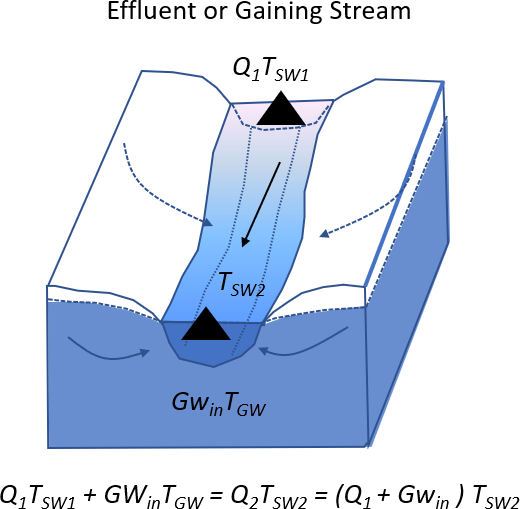Solution to Exercise 5
5) Under relatively simple conditions, the temperature of stream water can be used to estimate the net gain in groundwater for an effluent reach of stream. Figure 71 presents the concept. If the streamflow at the upstream site Q1 is 2.0 m3/s and the mixed stream water temperature is 12°C, the shallow groundwater system temperature is 8.2°C, and a stream temperature measurement at the downstream site, Q2, is 10.4°C, then:
SOLUTION:
a) Assuming that over this 2 km river reach the other components of the heat budget are small, what is the net quantity of groundwater that discharges to this river reach?
The equation presented in Figure 71 relates stream discharge and temperatures to groundwater input.

Based on the information given: Q1 = 2.0 m3/s; TSW1 = 12°C; TGW = 8.2°C and at 2 Km downriver the river temperature is 10.4°C. Thus, the GW discharge at 8.2°C over the 2 km reach is:
2.0 m3/s (12°C) + GWin (8.2°C) = (2.0 m3/s +GWin) (10.4°C)
24 m3/s °C + 8.2 GWin°C = 20.8 m3/s °C + 10.4 GWin °C
3.2 m3/s °C = 10.4 GWin °C – 8.2 GWin °C = 2.2 GWin °C
3.2 m3/s °C /2.2 °C = GWin = 1.45 m3/s
Over the 2 km reach 1.45 m3/s of groundwater entered the stream.
b) How could individual temperature monitors installed in the stream and stream bed be used to verify the stream is gaining in this reach?
A small diameter monitoring well or mini-piezometer could be installed at a number of locations in the 2 km long stream channel. Individual temperature recorders isolated in the well bore using baffles would provide vertical temperature readings. A second approach would be to insert a metal temperature probe into the bed and record temperature variations at multiple vertical locations. In either case, when groundwater is discharging to the stream the temperature in the stream bed will reflect the groundwater temperature. The temperature will remain constant as the sampling depth below the bed increases. Probes may only need to be inserted a few 10’s of centimeters into the bed. If a strong hyporheic exchange is also occurring in portions of the bed, stream water temperatures may influence the readings until probes are inserted to depths where the upwelling groundwater dominates.
